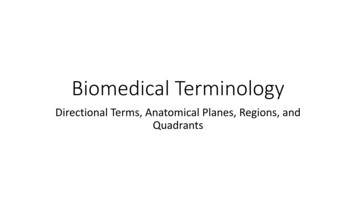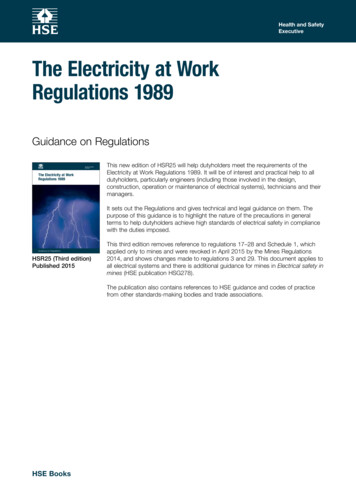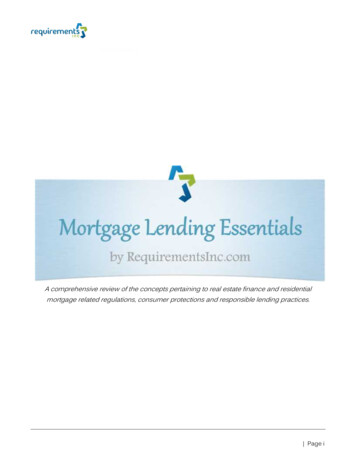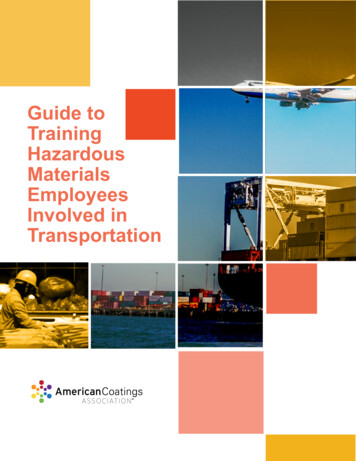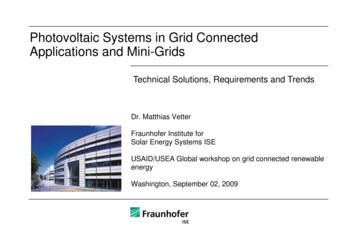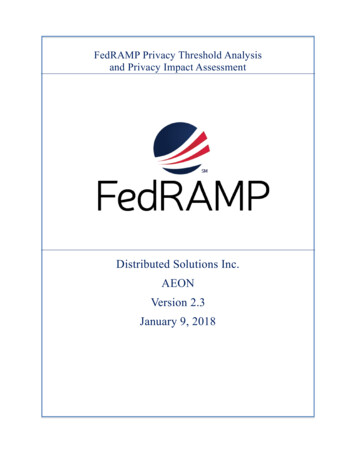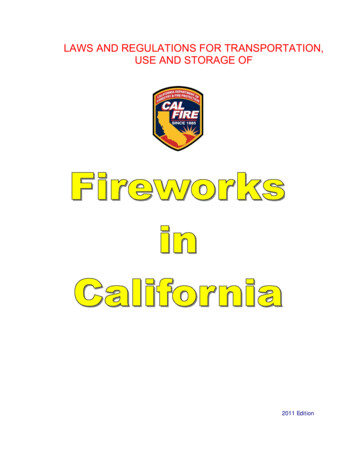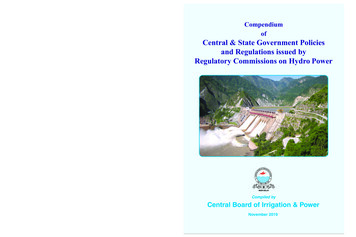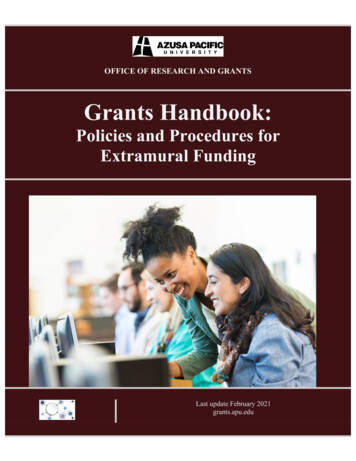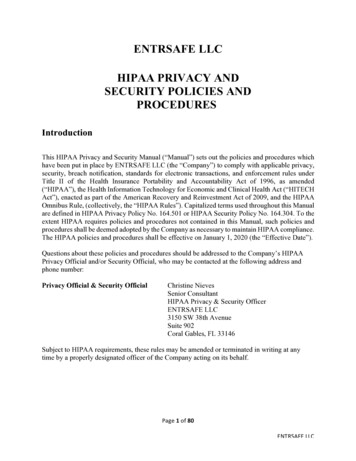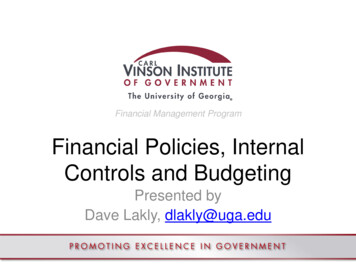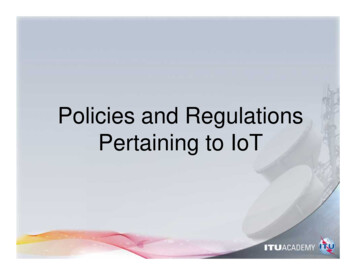
Transcription
Policies and RegulationsPertaining to IoT1
Organization of the ITU and its functioningITU UN specialized agency for ICTs standards developingMembers: 193 Member States(Governments and regulatorybodies) Over 700 Private Sector (SectorMembers and Associates) Over 90 Academiaorganization unique public/privatepartnership2
Brief introduction ITUITU at a glanceAbout usSpecialized Agencies of the United POIMOIAEAWFPIMFSpecialized UN agency with focus onTelecommunication / ICTs3
Brief introduction of ITUITU at a glanceWhere are we?PRESENCEJAKARTA4
Structure of ITUITU-T: standardizationStandardization(ITU-T)produces interoperabletechnical ICT standardsGeneral SecretariatStandardization(ITU-T)provides coordinationfor the whole organizationITU-R: Radio comm.Standardization(ITU-T)coordinates globalwireless communicationITU-D: DevelopmentStandardization(ITU-T)provides assistance tothe un-connected5
ITU at a glance04 Meet usWHO ARE WE?ITU Elections : during Highest Governance Forum i.e. Plenipotentiary conferenceITU retaryGeneralDirector of theDirector of ureau (BR)Director of theTelecommunication Bureau (BDT)StandardizationBureau (TSB)DURATIONA maximum of twofour-year terms inany elected post6
ITU at a glanceMeet usBut what about the time between plenipotentiary conferences?ITU Elections : during highest Governance Forum i.e Plenipotentiary conferenceDURATIONITU CouncilAfrica (13 seats)Western Europe(8 seats)Americas (9 seats)MEMBERSEastern Europe(5 seats)Elected for afour-year termAsia and Australasia(13 seats)7
ITU at a glanceAbout usWHAT WE DOCoordinating radiospectrum andassigning orbital slotsfor satellites‘Committed toConnecting theWorld’Bridging the digitaldivideEstablishing globalstandards8
ITU at a glanceMeet usWHO ARE WE?OrganizationSECTORS9
ITU at a glanceMeet usWHO ARE WE?OrganizationMembership InputsRPMWTSAWTDCTDAGSECTORSActionPlanStudy GroupsBDTTreatyWRCRPRRRActionPlanTSAGStudy GroupsTSBd.RARAGActionPlanStudy Groupsand CPMsBRAdvisoryTechnicalSecretariat10
IoT definition in the policy and regulatorycontextInternet of things (IoT) [ITU-T Y.2060]: A global infrastructure for theinformation society enabling advanced services by interconnecting(physical and virtual) things based on existing and evolving, interoperableinformation and communication technologiesNOTE 1 (from [ITU-T Y.2060]) – From a broad perspective, the IoT can beperceived as a vision with technological and societal implications.NOTE 2 (from [ITU-T Y.2060]) – Through the exploitation of identification,data capture, processing and communication capabilities, the IoT makesfull use of things to offer services to all kinds of applications, whilstensuring that security and privacy requirements are fulfilled.11
Emerging ICT Infrastructure andPolicy and Regulatory issuesPolicyRegulationStandardizationCross-Sector CollaborationTelecom/ ICTSector S/QoE,ConsumerNumbering & AddressingBig Data & Open DataSecurityRight of WayFigure source: ITU-T Focus Group on Smart Sustainable Cities: Overview of smart sustainable cities infrastructureA multi-tier SSC (smart sustainable city) ICT architecture from communication view (physicalperspective)PrivacyGreen ICTsInfrastructureSharingData ications12
Background In the IoT/M2M context as technologies enable deployment of IoTs ingeneral involves the ICT sector policy makers and regulators (who arealso going through a transformation otherwise) However, there are cases of standalone IoT use case for health,agriculture, finance that may not involve the ICT related policy makerand regulator. Furthermore in the context of IoTs some policy issues would have littleor no ICT regulatory implication such as taxation, R&D, Innovation andincubation, inter-sector deployment, capacity building, test beds, pilotprojects, inviting investments, ethical decision making that may berequired in IoTs like autonomous cars, etc.13
Background Contd. Policy issues driving IoT– Who would creating a policy for IoTs? ICT, Other sector, all?– Policy aspects that have ICT regulatory impact– Policy aspects that require other sectoral regulatoryintervention– Policy aspects that need industry, academia , R&D– Policies that needs international cooperation (Standards,spectrum, inter border movement, international taxation,international resources, data protection, security and privacy) In this presentation, we concentrate on the IoT thatinvolves the ICT sector policy maker and regulator whilehighlighting some of the issues related to internationalcooperation14
Background Contd. Form the ICT policy maker and regulator point of view some of thechallenges faced would be:– Licensing (new IoT aggregators, scope of license etc.)– Spectrum (regulation will change based on the service and also technology, e.g.Long range (NB-IOT, Sigfox, LoRA) Vs short range (RFID, Bluetooth, WiFi); It willalso change based on the band used (free vs licensed)– Numbering and addressing (IoT identifier)– International roaming– Interoperability and Standards (Discussed in detail other sessions)– Data protection, privacy, consumer protection and Security.– Competition (platform competition, can the whole business or a smart city betreated as one customer reducing choice)– RoW: Use of Street furniture– Tariff regulation (e.g. long term pricing)– USO (coverage by PoP or coverage by geography, scope of USO fund)– Quality of Service and Quality of Experience15
National Regulations There are many aspects of regulations that arenational in nature Such as how to assign spectrum totelecommunication operators, decision to havenational level licensing or region based licensing andmany others Even national regulations have to be aligned to bestpractices to avoid issues such as cross borderinterference, technology neutrality, roaming, feestructure, etc16
National Regulations Governments generally have lots of freedom inadopting national regulations. It is, however, always advisable to follow bestpractices. ITU has published many documentthat can be used to have an idea about bestpractices17
Historic Perspective of ICT Regulation With the growth in Internet and availability of wirelessbroadband technologies paved the way for many newservices The expectation and role of ICT was to changedramatically but generally regulations lagged behindthe technologies Regulators are still coping with the issues related toOver The Top (OTT) services and the need to balance anew imbalance that has been where these traditionalservices provided by the telecommunication servicesprovider18
Historic Perspective of ICT Regulation Internet now a days is used provide all kind ofservices. This has led to convergence of someregulator specially the ICT and the MediaRegulators. ICTs have now role including but not limited toDigital Financial Services, E-Health, EAgriculture and even Transportation whereservices like Uber have been launched.19
Historic Perspective of ICT Regulation ICT Regulations has in many ways become morecomplicated as there are issues related to security, privacy,data protection and even services that disrupt traditionalservices like Uber that had impacted the transportationsector and related jobs. Huge amount of data is generated by people and otherconnected devices. This data can be used to obtain usefulinformation using Big Data Analytics and the decisions canbe based on the analysis using Artificial Intelligence. These and others are known to be the components of thefourth industrial revolution that is based on the “cyberphysical” systems.20
Historic Perspective of ICT Regulation The ICT or the converged regulator has to work with manyother regulators and departments as well as the privatesector. Thus the new era of regulations is called thecollaborative regulations The role of the ICT regulator has become more of afacilitator, where on hand it still has to work on enhancingconnectivity, while on the other hand it has to work withothers to promote the use of ICTs in all the different areaslike financial inclusion, health and agriculture.21
Generations of Regulators 1G: Regulated Monopolies: 2G: Basic Reforms: De-Regulation 3G: Enabling Environment Broadband Spectrum Allocation for MBB 4G: Integrated Regulations Internet related issues Light Touch Regulations 5G: Collaborative Regulations22
5th Generation Regulations: Collaboration Services over the Internet– Health– Education– Agriculture– Financial (Branchless Banking)– Media– Smart Cities (IoT, Big Data Analytics)– Other (Taxi, Hotel, Job Portals, etc)23
Collaborative RegulationsSource: ITU24
ICTs are nvestmentGovernanceApplicationsPolicy & RegulationCapacity BuildingIoT, SensorNetworksTransportUniversal BroadbandGreen ICT & E-WasteMeasurementsElectricityPrivacy & SecurityInfrastructure SecurityWaterSMARTDigital InclusionSOCIETYSpectrum ManagementStandards, Conformity &C&IInteroperabilityFinance25
ICT and agriculture application trendsSource: FAO-ITU E-agriculture Strategy Guide26
Be He@lthy Be Mobile:Scaling up Digital HealthGlobally27
The toolkits"We should allwork to meettargets to sionmCervicalCancermHEALTH ENABLESPUBLIC HEALTHSERVICES TO existing infrastructure Scale up delivery of healthprograms cost effectively Reduce NCD prevalence Save costs on healthcaremAgeingmTuberculosis Tobacco .28
Policy Framework to Enable IoT IoT is quite different from the generalconnectivity that the ICT regulators strive toenable In connecting people the “connectivity” is themain service, whereas in IoT it is the Applicationand related device and sensors Business models are different, so is the footprint29
Policy Framework to Enable IoT The policies must address the previouslyunaddressed issues like privacy, dataprotection and security Whereas some known issues such as spectrumallocation and licensing requires a re-work30
IoT AND REGULATORY AUTHORITY31
IoT policy and legislation32
ITU-T Study Group 20: Internet of things (IoT)and smart cities and communities (SC&C)Lead study grouponResponsible for studiesrelating to IoT and itsapplications, and smart citiesand communities (SC&C).Internet ofthings (IoT) andits applicationsIt includes studies relating toBig data aspects of IoT andSC&C, e-services and smartservices for SC&CSmart Cities andCommunities(SC&C), includingits e-servicesand smart servicesIoT identification33
ITU-T SG20 StructureWP1/20QuestionsQ1/20End to end connectivity, networks, interoperability, infrastructuresand Big Data aspects related to IoT and SC&CQ2/20Requirements, capabilities, and use cases across verticalsQ3/20Architectures, management, protocols and Quality of ServiceQ4/20e/Smart services, applications and supporting platformsWP2/20Q5/20Research and emerging technologies, terminology and definitionsQ6/20Security, privacy, trust and identificationQ7/20Evaluation and assessment of Smart Sustainable Cities andCommunities34
IOT Value ChainITU ASP ROSource: BEREC Report “Enabling the Internet of Things”12 February 201635
SERVICE LICENSING ISSUES A large number of countries still have service specific licensing frameworkWhat type of telecom service does the IoT provides?What about services that are cross-sectoral in character? Licensed Vs Non-licensedservicesHow and to whom do the rights and obligations apply? Licensees, Resellers, Others ?AfricaUnified / Global License9Authorization Multi service1type *Multiservice individual license4Service-specific individual license20General Authorization (Class4License)License Exempt2Simple notification1Remarks11Region size44* This indicator allows multiple choice per country/economySource: ITU World Telecommunication/ICT Regulatory DatabaseNumber of countries/economiesArabAsia &CIS Europe 95ITU ICT-Eye: http://www.itu.int/icteye36
INTEROPERABILITY AND STANDARDS IoTs have both public and proprietary standards currently Standardization is important for Interoperability, reducing costs and barriersto entry ITU-T SG 20 (IoT and Smart Cities, Smart Communities) National Standardization bodies International Standardization bodies How to coordinate interoperability amongst public and private sectorentities? For example parking meters, thermostats, cardiac monitors, tires, roads,car components, supermarket shelves Cross-sectoral collaboration is very important as IoT are deployed inmultiple sectors37
NUMBERING, ADDRESSING AND NUMBERPORTABILITY ISSUES Public Numbers National E.164 numbers; International/global E.164 numbers assigned by the ITU; National E.212 IMSI (International Mobile Subscriber Identity); International/global E.212 IMSI with MNCs under MCC40 901assigned by the ITU. Eligibility to receive MNCs Sufficiency of numbering resources IP addresses (IPv4 to IPv6 transition) MAC addresses How to switch the IoT devices when changing operators? OTA (Over-the-air) programming of SIMsSource: BEREC Report “Enabling the Internet of Things”12 February 2016,38
PRIVACY AND SECURITY ISSUES Privacy Issues as in IoT environment, data is collected and shared automatically bydevices, and some may be critical in nature Data protection vs Open data Applicable laws Entity responsible for data protection Who can have access to the data collected? Data classification and processing Consent of data owner? National vs International collection and sharing of dataSecurity of device and dataConsumer protectionIoT devices should follow a security and privacy “by design” approach39
PRIVACY AND SECURITY ISSUES:Potential regulatory measures R&D on more hardware and software security and privacy mechanismsfor resource‐constrained IoT systems Incentives for companies to develop new mechanisms to improvetransparency of IoT personal data use, and for gaining informed consentfrom individuals concerned when sensitive data is gathered or inferencesdrawn. Greater use of Privacy Impact Assessments by organizations building andconfiguring IoT systems. More cooperation between telecoms and other regulators such asprivacy/data protection agencies.Source: GSR discussion paper Regulation and the Internet of Things, 201540
COMPETITION ISSUES Licensed Vs Non Licensed servicesArea of licenseOTTNet NeutralityInfrastructure sharingAccess to data and open IoT platformsData analyticsCustomer lock-inMobile data roamingConsumer protectionQuality of Service41
COST AND RELIABILITYSource: GSR discussion paper Regulation and the Internet of Things, 2015, Prof. Ian Brown42
Spectrum Requirement for IoT In many cases IoT devices need to use Wireless Technologies Diversity of IoT application requirements:––––Varying bandwidth requirements (how much information is sent)Long-range vs short-rangeLong battery lifeVarious QoS requirementsIoTs and cloud technologies and are the two unstoppable forces promoting digital capabilitiesSpectrum needs to be made available in a range of frequency bands to cater for various cases43
Example from Singapore44
Example from AustraliaSource: The Internet of Things and the ACMA’s areas of focus Emerging issues in media and communications Occasional paper, Nov 201545
IoT Addressing IoT devices may have a globally unique androutable communications address This will require a very large protocol addressspace Thus allowing limited inter‐network connectivity;or make use of local networks only to share datawith and receive instructions from a nearbycontroller.46
IoT Addressing In some cases these devices can be a computer,smartphone, or specialized management device – inwhich case a globally‐unique address is not required Enabling peer‐to‐peer connections between devicescan increase the reliability of communications,compared to requiring a large and complex globalnetwork This matches the common use case of an individualdiscovering and interacting with nearby devices.47
IoT Addressing However when devices must be globally reachable – mostlikely, via the Internet, a large space is required toindividually identify each IoT The number of unallocated addresses for the current versionof the Internet Protocol (IPv4) is extremely limited, but thenew version (IPv6) being rolled out by ISPs around the worldhas enough addresses for almost any conceivable number ofdevices. The transition from IPv4 to IPv6 has taken longer thanexpected, and policy makers may need to continue withprogrammes to encourage the transition in the mediumterm.48
IoT Addressing The US government example, set up a Federal IPv6 TaskForce to move all federal agencies from IPv4 to IPv6,with one aim being to encourage the private sector todo the same. Many other countries have also set upIPv6 Task Forces to encourage national transitions For any IoT identification scheme, there will betrade‐offs between performance, scalability,interoperability, efficiency, privacy preservation, easeof authentication, reliability, flexibility, extensibility,and mobility support.49
IoT Addressing Beside the IPv6 addresses system, the other mainidentification standards being developed arefrom ISO and GS1, as well as ITU‐TRecommendation E.212 for the use of theInternational Mobile Subscriber Identifier (IMSI)for machine‐to‐machine communications The latter has the advantage of a well‐developedauthentication, payment and global roamingframework, operated by mobile telephonyproviders, with hardware security based on SIMs50
IoT roaming The term roaming is usually used in the context ofcellular communication IoTs on the other hand are based on several differenttechnologies. In fact the IoT based on cellulartechnologies would be a small portion of the total IoTmarket. The IoTs may also be agnostic of thetechnology that is used at the physical layer. The technology agnostic part will be speciallysignificant once we have complete implementation ofIPv651
IoT Roaming: Cellular In general many National Regulatory Authority atthis point in time are working on or haveregulations related to cellular technology basedIoTs These IoTs may have a regular SIM card or mayhave an embedded SIM There is a need to look at the issue of roaming ina more comprehensive manner in general contextof regulations related to IoTs52
IoT Roaming: Other Technologies Technologies other than cellular technologies, likeLoRa, Sigfox networks may also require similarroaming agreements This may require agreements between Sigfox orLoRa network operators Such time of roaming for the time being has notcaught the attention of regulators but with mayrequire handling in the future.Source: BEREC Report “Enabling the Internet of Things”12 February 201653
Regulation on street furniture usagewhere IoT devices The Street furniture is usually the property orunder control of the local administration Even in presence of a National Policy related toInfrastructure, the local government may havethere own policy, rules and regulations As an example, the council in Milton Keynes cameup with their own Telecommunication Policy thatamong many other factors also considered theenvironmental impactsSource: Telecommunication Systems Policy, Council of Milton Keynes54
Infrastructure Sharing In telecommunication infrastructure sharing isbecoming very popular because of its environmentalimpact and cost savings The use of street furniture for IoTs can be consideredas an extension of this policy albeit across severalstakeholders In fact this use of furniture may not only be for IoT butfor providing broadband services to the people and inthe longer run for 5G services, where IoT will just beone part55
Use of Street Furniture In general it is usually considered a given thatstreet furniture will be used for IoT However, the regulations are in this regard areunclear More precisely, the exact jurisdiction is blurry56
Use of Street Furniture Delivering extensive coverage at high dataspeeds and with robust reliability, with eachoperator running a separate network, wouldrequire vast levels of investment There must be an increased role forinfrastructure sharing, not only to reduce thecosts of network deployment where possible.Source: National Infrastructure Commission of UK report Connected Future57
Use of Street Furniture The networks of the future must make thebest use of the limited supportinginfrastructure such as street furniture in thetowns and cities Any regulation of network infrastructureshould seek to be supportive of this sharing,whilst ensuring competition and fair accessare maintained.Source: National Infrastructure Commission of UK report Connected Future58
Use of Street Furniture: Example A notable feature of small cell densification and IoT will be theneed for access to street furniture. This will require collaboration between network operators andlandlords (generally local authorities) to handle agreementsand issues that might occur due to deployingtelecommunications equipment on infrastructure not designedfor that purpose There is currently no common approach to this type ofcollaboration, though pioneering Smart cities projects such asBristol is Open and collaborations between forward thinkingauthorities such as Aberdeen Council and network providerswill offer valuable insight into how best to drive networkprovisionSource: National Infrastructure Commission of UK report Connected Future59
General regulatory issues around data60
General Regulatory Issues around Data Now-a-days not only IoT collect data but many otherplatforms (e.g., social media) collect data At times the collected data is shared without theknowledge of the users (or the user has naively giventhe permission in order to subscribe to a certainservice). Data is stolen from these platforms Many countries in the world are trying to come up withregulations to protect user data61
General Regulatory Issues around Data Many Countries and regions still have no grasp of the issue anddo not have any specific regulations or in some cases they havevery old regulations that are too restrictive Following are some of the principles that need to be adheredto when regulations are laws and regulations are promulgated Data protection vs Open dataEntity responsible for data protectionWho can have access to the data collected?Data classification and processingConsent of data owner?National vs International collection and sharing of dataConsumer protection62
Potential Regulatory Measures Incentives for companies to develop new mechanisms forgaining informed consent from individuals concerned whensensitive data is gathered or inferences drawn. Greater use of Privacy Impact Assessments by specializedorganizations Development of further guidance from global privacyregulators on application of the principles of dataminimization More cooperation between telecoms and other regulatorssuch as privacy/data protection agencies.Source: GSR discussion paper Regulation and the Internet of Things, 201563
Regulatory issues around data Different Regions and even individual countries inthe same region deal with data issues differently The main problem stem from the fact that mostof the ICT regulator have evolved from regulatingthe Telecommunication sector. The telecommunication services were and arelicensed services and the regulators throughlicense conditions used to impose restriction onuse of consumer data64
Regulatory issues around data The main data used to be the Call Detail Record (CDR) and thesubscriber antecedents. The Telecommunication companieshad the data and they were suppose to keep it safe However, with the increase in the availability of mobilebroadband, smart phones equipped with a GPS receiver,different applications have been launched by manycompanies and are providing different kind of services. Theseare generally called Over the Top (OTT) Services These OTT services collect lots of user and then there are databreaches etc65
Regulatory issues around data Some countries have a established a separate entity forData Protection ICT Regulator still maintain some control over howdata should be shared The main issues faced are as follows:– With whom and how (e.g. anonymization) data should beshared– What kind of data has to remain within the geographicalboundaries and which can reside outside the country66
Regulatory issues around data The data generation by the users has enhanced many folds This data can be used in the decision making process formany applications both in the private as well as thegovernment sector. New technologies are like IoTs has the potential to generateeven more data then people can Technologies like Cloud computing, do require data to beplaced at different locations that may be out side thegeographical boundaries of a country.67
Regulatory issues around data Large amount of data can only be usedthrough big data analytics again requiring theuse of cloud computing These analysis are required in artificialintelligence Therefore, there is a need to have leastrestrictive regulations around data sharing68
Regulations around Data in Asia As pointed out earlier Data regulations are at differentstages even within the same region In general the regulations are more advanced incountries that are doing well in general in the ICTsector. For example in Singapore, the main law on thisissue is the Personal Data Protection Act 2012. It isquite comprehensive and covers many differentaspects. On the other hand, in Vietnam there is no unified lawregulating data privacy69
Regulations around Data in the United States In the United States, the privacy and security of personaldata is governed by a wide range of federal and state laws At the highest level, the Fourth Amendment to the UnitedStates Constitution protects "the right of the people to besecure in their persons, houses, papers, and effects, againstunreasonable searches and seizures In the regulatory sector, multiple federal agencies enforcevarious privacy laws tailored to specific industries, or typesand uses of information.Source: Data protection regulations and international data flows: Implications for trade anddevelopment, United Nations Conference on Trade and Development (UNCTAD) Report, 201670
Regulations around Data in the United States These laws include but not limited to health information,financial information, educational records, children'sinformation, and governmental use of personal data The regulatory agencies tasked with their enforcementinclude but not limited to the Federal Trade Commission(FTC), the U.S. Department of Health and Human Services(HSS), the Consumer Financial Protection Bureau (CFPB),and the Federal Communications Commission (FCC). Thereare also state level agencies, including State Attorneysgeneral, that enforces state privacy laws.Source: Data protection regulations and international data flows: Implications for trade anddevelopment, United Nations Conference on Trade and Development (UNCTAD) Report, 201671
Regulations around Data in the European Union The main regulation in the EU is the General DataProtection Regulation (GDPR) The GDPR provides for a uniform and simplifiedlegislative framework It will establish one single pan-European set of rulesthat will make it simpler and cheaper for companiesto do business in the EU72
Regulations around Data in the European Union The GDPR envisages that– the rights of individuals are more effectivelyprotected across the continent– consistency of interpretation of the new rules beguaranteed– in cross-border cases where several national dataprotection authorities are involved, a singlesupervisory decision is adopted73
Adequacy Approach of GDPR The 'adequacy' approach (sometimes knownas a whitelist approach) assesses whether anentire target jurisdiction provides a sufficientdegree of protection for the transfer ofpersonal data This approach is used by a variety of countries,including the members of the European Union(EU), Israel, Japan and Switzerland74
EU and the United States The European Union and the United Stateshave re-negotiated a long standing crossborder data protection agreement It used to be called the EU-US Safe HarborFrameworks, now to be known as the EU-USPrivacy Shield75
EU and the United States The EU-U.S. Privacy Shield Frameworks weredesigned by the U.S. Department of Commerce,and the European Commission The objective was to provide companies on bothsides of the Atlantic with a mechanism to complywith data protection requirements whentransferring personal data from the EuropeanUnion to the United States in support oftransatlantic commerceSource: https://www.privacyshield.gov/Program-Overview76
The Privacy Shield Model The Privacy shield model has been followedelsewhere also For example, Switzerland and Israel bothpublish lists of jurisdictions where data can besent because their laws have been approvedas adequate.77
Data regulation and data protectionlaws specifically pertinent to the IoTs In general, all the general data protectionregulations are also applied to IoTs There may be additional requirements for IoTs As an example and a case study, this issue isconsidered in light if the European Union’sGeneral Data Protection Regulation ("GDPR") ispresented78
GPDR and IoT The data protection issues arising from the IoT wereconsidered in a
Policy Framework to Enable IoT IoT is quite different from the general connectivity that the ICT regulators strive to enable In connecting people the "connectivity" is the main service, whereas in IoT it is the Application and related device and sensors Business models are different, so is the footprint 29
